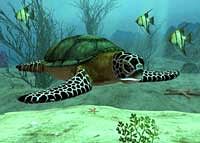Sea turtles under threat in Kerala

The number of sea turtles along the Kerala coast was fast dwindling in the last few years due to habitat destructions, poaching, marine debris and fishing activities, according to A Biju Kumar, conservationist and faculty member of Department of Aquatic Biology, Kerala University.
With the "unscientific construction" of granite walls along seashores, turtles were being deprived of even a small slope in beaches to get to the sands for hatching, he said.
Out of the 590 km-long stretch of coastline in the state, only about 150 km is now without any kind of sea walls, he pointed out. "The turtles need at least a small slope to get to the coast for hatching," he said.
Olive Ridley is the common sea turtle found in the region along with hawksbill, green and leatherback turtles, he said.
The green turtles sighted in Ponnani coast in the Malabar region, have not been seen for the past years now, he said.
The dwindling number of turtles is a cause of concern to conservationists as it might take another 25 years for them to come back to our coastal belt once they stopped hatching here.
"Once they stop coming to the seashore for hatching, the turtles will not come to our coast for the next two decades," Kumar said.
As part of conservation measures, formation of a 'Model Coastal Eco-Development Committee' had been proposed for the Vizhinjam coast near here as a pilot project, Bijukumar said.
The committee would ensure the involvement of local community in the conservation efforts.
Wildlife and bio-diversity outside forests does not get the same level of significance as other animals coming under the Wildlife Protection Act like tigers and leopards, he said.
"Also, when we look at the extent, oceans and marine ecosystem forms the world's largest ecosystem covering about 70 per cent or more of the earth's surface," he pointed out.
A multi-pronged approach was necessary for the protection and conservation of our marine and coastal ecosystem and its bio-diversity, he added.
As a first step in conserving sea turtles, their existing breeding places had to be protected and strict monitoring was required to avoid any human activity in their territory.
Besides, involvement of local community in protection and conservation was essential to tackle the problem of poaching and hunting of the turtles, he said.
Though the sale of sea turtles was banned, trade in its meat was still on in many places of the state particularly in southern Kerala, he said.
Jayakumar, an activist of 'Thanal', an NGO working in the environmental field, said the increase in the number of outboard engine fishing boats had also driven away sea turtles from the Kerala coast.
Mortality rate of sea turtles due to accidents involving outboard engine boats was also high, Jayakumar, who conducted a study on sea turtles for the Centre for Development Studies, said.
The conservation of sea turtles also comes under the purview of the Forest Department.
But, the department does not have the required Marine Division and mechanism to enforce measures to protect and conserve sea turtles, he said.
Deccan Herald is on WhatsApp Channels| Join now for Breaking News & Editor's Picks